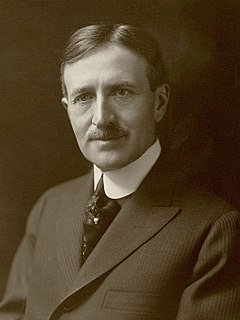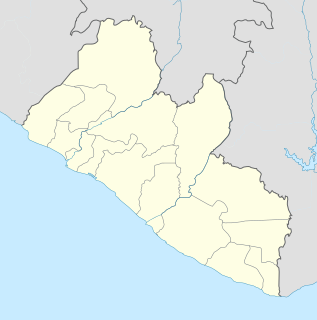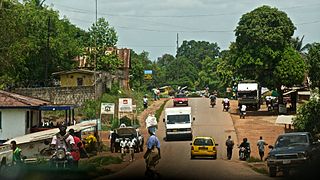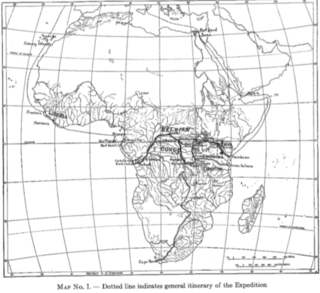
The Amazon River in South America is the largest river by discharge volume of water in the world, and the disputed longest river in the world.
The economy of Liberia is extremely underdeveloped, largely due to the First Liberian Civil War (1989–1996). Liberia itself is one of the poorest and least developed countries in the world.

Harvey Samuel Firestone was an American businessman, and the founder of the Firestone Tire and Rubber Company, one of the first global makers of automobile tires.

Montserrado County is a county in the northwestern portion of the West African nation of Liberia containing its national capital, Monrovia. One of 15 counties that comprise the first-level of administrative division in the nation, it is composed of four districts. As of the 2008 Census, it had a population of 1,118,241, making it the most populous county in Liberia. The area of the county measures 1,912.7 square kilometres (738.5 sq mi), the smallest in the country. Bensonville serves as the capital.
Firestone Tire and Rubber Company is an American tire company founded by Harvey Firestone in 1900 initially to supply solid rubber side-wire tires for fire apparatus, and later, pneumatic tires for wagons, buggies, and other forms of wheeled transportation common in the era. Firestone soon saw the huge potential for marketing tires for automobiles, and the company was a pioneer in the mass production of tires. Harvey Firestone had a personal friendship with Henry Ford, and used this to become the original equipment supplier of Ford Motor Company automobiles, and was also active in the replacement market.

Edwin James Barclay was a Liberian politician, poet, and musician who served as the 18th President of the country from 1930 until 1944. He was a member of the True Whig political party, which dominated the political governance of the country for decades. Under Barclay's leadership, Liberia was an ally of the United States during World War II.

Margibi is a county on the north to central coast of Liberia. One of 15 counties that constitute the first-level of administrative division in the nation, it has five districts. Kakata serves as the capital with the area of the county measuring 2,616 square kilometres (1,010 sq mi). As of the 2008 Census, it had a population of 199,689, making it the sixth most populous county in Liberia.

Harbel is a town in Margibi County, Liberia. It lies along the Farmington River, about 15 miles upstream from the Atlantic Ocean. It was named for the founder of The Firestone Tire & Rubber Company, Harvey S. Firestone, and his wife, Idabelle. Since 1926, Harbel has been home to a massive natural rubber plantation which is still operated by the Firestone subsidiary of Bridgestone.

Kakata, is the capital city of Liberia's Margibi County and is located in Kakata District just over the Du River bridge which is its border with Todee District. It is a transit town at the heart of the historical natural rubber cultivation belt in Liberia. The city is colloquially known as "Kak City". The City host the Office of the National Civil Society Council of Liberia, Margibi Chapter. The Council which is headed by Mr. Friday Edwin Crusor, is known for its diligent role in Advocacy, Dialogue, and Peacebuilding among others.
Harvey Samuel Firestone Jr. was an American businessman. He was chairman of the board of the Firestone Tire and Rubber Company.
A new civil war began in 1999 when a rebel group backed by the government of neighboring Guinea, the Liberians United for Reconciliation and Democracy (LURD), emerged in northern Liberia. By the spring of 2001, they were posing a major threat to the Taylor government. Liberia was now engaged in a complex three-way conflict with Sierra Leone and the Guinea Republic. By the beginning of 2002, both of these countries were supporting the latest addition to the lexicon of Liberian guerrilla outfits – Liberians United for Reconciliation and Democracy (LURD), while Taylor was supporting various opposition factions in both countries. By supporting Sierra Leonean rebels, Taylor also drew the enmity of the British and Americans.

Liberia – United States relations are bilateral relations between Liberia and the United States.
The Firestone hydroelectric power station is a hydroelectric power station in Liberia on the Farmington River. Built in 1942, it was the first power generating dam built in the country. Located in Harbel, Margibi County, it is operated by the Firestone Plantations Company.

The Saint John River is one of the six main rivers in the West African nation of Liberia. With its headwaters in neighboring Guinea, the river flows generally southwest through Liberia and empties into the Atlantic Ocean at Bassa Cove near Edina in Grand Bassa County. The 175-mile-long (282 km) river has a drainage basin covering 5,700 square miles (15,000 km2).
Duside Hospital is a hospital in Firestone District, Margibi County, Liberia. It holds 300 beds and is operated by the Firestone Tire and Rubber Company. It reopened in December 2008 and in January 2010, was considered one of the best hospitals in Liberia.
Firestone Natural Rubber Company, LLC is a subsidiary of the Bridgestone Americas, Inc. Headquartered in Nashville, TN, the company operates the largest contiguous rubber plantation in the world in Harbel, Liberia, which first opened in 1926.
The Booker Washington Institute (BWI) is a public, post-secondary school in Kakata, Margibi County, Liberia. Founded in 1929 as the Booker Washington Agricultural and Industrial Institute, it was the country's first agricultural and vocational school. BWI was founded with assistance from Americans and is named after American educator Booker T. Washington. Located east of the country's capital of Monrovia, the school sits on a large rural campus and has about 1,800 students.

Liberia did not become militarily involved in World War II until January 1944, with the election of William Tubman, at which time the country declared war on Germany and Japan. However, even before the start of Liberia's official military involvement, the nation participated in the war for two years under the terms of a Defense Agreement with the United States. Apart from Ceylon and the Belgian Congo, Liberia possessed one of the few remaining sources of rubber for the Allies. To guarantee a steady supply of rubber from the world's largest rubber plantation, operated at Harbel by the Firestone Company since 1926, the US government built roads throughout the country, created an international airport, and transformed the capital, Monrovia, by building a deep water port.

Marshall is a town in Margibi County, Liberia. It borders the Atlantic Ocean. The Farmington River empties into the Atlantic Ocean near Marshall.

The Harvard Medical African Expedition of 1926–1927 was an eight-man venture sent by Harvard University for the primary purpose of conducting a medical and biological survey of Liberia; the secondary purpose being to then cross Africa from coast to coast - west to east - through the Belgian Congo so as to make a comparative study of their Liberian findings. Furthermore, the Liberian interior was next of kin to being terra incognita in the West, there having been no previous medical or scientific survey of the region, nor any recorded expedition into the Liberian hinterlands. The Expedition leader was Richard Pearson Strong, with the others being zoologists Harold Jefferson Coolidge Jr. and Dr. Glover Morrill Allen, entomologist Dr. Joseph Charles Bequaert, botanist and Washington University Professor David H. Linder, bacteriologist Dr. George C. Shattuck, bacteriologist Dr. Max Theiler, and Assistant Ornithologist Loring Whitman. The Expedition was a success and, while its "chief objective was the investigation of tropical diseases, many zoological specimens were collected and the customs of the native tribes were studied." The story of their travels back and forth across Liberia, and reports of the diseases found that ailed the inhabitants, animals and plants was published in the two-volume The African Republic of Liberia and the Belgian Congo: Based on the Observations Made and Material Collected during the Harvard African Expedition, 1926-1927 written by Dr. Strong in a partnership with other Expedition members and Harvard officials.














